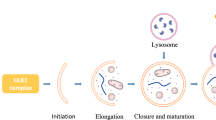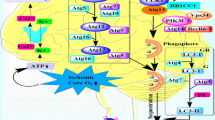Abstract
Hemorrhagic stroke includes cerebral hemorrhage and subarachnoid hemorrhage. An increasing number of studies have found that autophagy also occurs in brain tissues after cerebral hemorrhage and subarachnoid hemorrhage. The potential role of selective autophagy in the clinical treatment of hemorrhagic stroke has been recognized, but a consensus on the exact effect and function of autophagy has not been reached, and the mechanism needs to be further studied. In this chapter, the mechanism of brain injury after cerebral hemorrhage and subarachnoid hemorrhage is briefly introduced, and changes in the autophagy pathway and the role of autophagy in the process of brain injury are discussed.
Access this chapter
Tax calculation will be finalised at checkout
Purchases are for personal use only
Similar content being viewed by others
References
Chang P, Dong W, Zhang M et al (2014) Anti-necroptosis chemical necrostatin-1 can also suppress apoptotic and autophagic pathway to exert neuroprotective effect in mice intracerebral hemorrhage model. J Mol Neurosci 52:242–249
Chen RR (2012) Effect of naoxetong on autophagy in peripheral tissues of hematoma lesions after cerebral hemorrhage in rats. Master’s thesis
Chen TY, Tsai KL, Lee TY et al (2010) Sex-specific role of thioredoxin in neuroprotection against iron-induced brain injury conferred by estradiol. Stroke 41:160–165
Chen CW, Chen TY, Tsai KL et al (2012) Inhibition of autophagy as a therapeutic strategy of iron-induced brain injury after hemorrhage. Autophagy 8:1510–1520
Chen J, Wang L, Wu C et al (2014) Melatonin-enhanced autophagy protects against neural apoptosis via a mitochondrial pathway in early brain injury following a subarachnoid hemorrhage. J Pineal Res 56:12–19
Chen S, Wu H, Tang J et al (2015) Neurovascular events after subarachnoid hemorrhage: focusing on subcellular organelles. Acta Neurochir Suppl 120:39–46
Chen N, Dai L, Jiang Y et al (2016) Endoplasmic reticulum stress intolerance in EIF2B3 mutant oligodendrocytes is modulated by depressed autophagy. Brain Develop 38:507–515
Fang Y, Chen S, Reis C et al (2018) The role of autophagy in subarachnoid hemorrhage: an update. Curr Neuropharmacol 16(9):1255–1266
Gong Y, Hua Y, Keep RF et al (2004) Intracerebral hemorrhage: effects of aging on brain edema and neurological deficits. Stroke 35:2571–2575
Gong Y, He Y, Gu Y et al (2011) Effects of aging on autophagy after experimental intracerebral hemorrhage. Acta Neurochir Suppl 111:113–117
He Y, Hua Y, Song S et al (2008a) Induction of autophagy in rat hippocampus and cultured neurons by iron. Acta Neurochir Suppl 105:29–32
He YD, Wan S, Hua Y et al (2008b) Autophagy after experimental intracerebral Hemorrhage. J Cereb Blood Flow Metab 28:897–905
Hua Y, Keep RF, Hoff JT et al (2007) Brain injury after intracerebral hemorrhage: the role of thrombin and iron. Stroke 38(Suppl):759–762
Ji C, Chen G (2016) Signaling pathway in early brain injury after subarachnoid hemorrhage: news update. Acta neurochirurgica. Supplement 121:123–126
Jing ZH (2012) Role and mechanism of autophagy in early brain injury after subarachnoid hemorrhage in rats. Doctoral dissertation, III
Jing CH, Wang L, Liu PP et al (2012) Autophagy activation is associated with neuroprotection against apoptosis via a mitochondrial pathway in a rat model of subarachnoid hemorrhage. Neuroscience 213:144–153
Keep RF, Hua Y, Xi GH (2012) Intracerebral haemorrhage: mechanisms of injury and therapeutic targets. Lancet Neurol 11:720–731
Lee JY, He YD, Sagher O et al (2009) Activated autophagy pathway in experimental subarachnoid hemorrhage. Brain Res 1287:126–135
Li J, Lu JF, Mi YJ et al (2014) Voltage-dependent anion channels (VDACs) promote mitophagy to protect neuron from death in an earlybrain injury following a subarachnoid hemorrhage in rats. Brain Res 1573:74–83
Li T, Sun KJ, Wang HD et al (2015) Tert-butylhydroquinone ameliorates early brain injury after experimental subarachnoid hemorrhage in mice by enhancing nrf2-independent autophagy. Neurochem Res 40:1829–1838
Li H, Wu J, Shen H et al (2017) Autophagy in hemorrhagic stroke: mechanisms and clinical implications. Prog Neurobiol. https://doi.org/10.1016/j.pneurobio.2017.04.002
Liu Y, Cai H, Wang Z et al (2013) Induction of autophagy by cystatin C: a potential mechanism for prevention of cerebral vasospasm after experimental subarachnoid hemorrhage. Eur J Med Res 18:21
Liu RY, Wang JJ, Qiu X et al (2014a) Acute hyperglycemia together with hematoma of high-glucose blood exacerbates neurological injury in a rat model of intracerebral hemorrhage. Neurosci Bull 30:90–98
Liu Y, Li J, Wang Z et al (2014b) Attenuation of early brain injury and learning deficits following experimental subarachnoid hemorrhage secondary to Cystatin C: possible involvement of the autophagy pathway. Mol Neurobiol 49:1043–1054
Qureshi AI, Suri MF, Ostrow PT et al (2003) Apoptosis as a form of cell death in intracerebral hemorrhage. Neumsurgery 52:1041–1047
Roof RL, Hall ED (2000) Gender differences in acute CNS trauma and stroke: neuroprotective effects of estrogen and progesterone. J Neurotrauma 17:367–388
Urday S, Kimberly WT, Beslow LA et al (2015) Targeting secondary injury in intracerebral haemorrhage-perihaematomal oedema. Nature Reviews Neurology 11:111–122
Wang Z, Shi XY, Yin J et al (2012) Role of autophagy in early brain injury after experimental subarachnoid hemorrhage. J Mol Neurosci 46:192–202
Wu J, Hua Y, Keep RF et al (2003) Iron and iron-handling proteins in the brain after intracerebral hemorrhage. Stroke 34:2964–2969
Wu J, Jia JP, Cui LY (2010) Neurology. People’s Health Publishing House. p 170
Wu Y, Wang L, Hu K et al (2018) Mechanisms and therapeutic targets of depression after intracerebral hemorrhage. Front Psychiatry 9:682
Xi G, Keep RF, Hoff JT (2006) Mechanisms of brain injury after intracerebral haemorrhage. Lancet Neurol 5:53–63
Yan F, Li JR, Chen JY et al (2014) Endoplasmic reticulum stress is associated with neuroprotection against apoptosis via autophagy activation in a rat model of subarachnoid hemorrhage. Neurosci Lett 563:160–165
Yang Z, Zhang N, Liu Y et al (2014) TLR4-mediated autophagy contributes to microglial activation and inflammatory injury in mouse models of intracerebral haemorrhage. Neuropathol Appl Neurobiol 41:e95–106
Zhao H, Ji Z, Tang D et al (2013) Role of autophagy in early brain injury after subarachnoid hemorrhage in rats. Mol Biol Rep 40:819–827
Zia E, Engström G, Svensson PJ et al (2009) Three-year survival and stroke recurrence rates in patients with primary intracerebral hemorrhage. Stroke 40:3567–3573
Author information
Authors and Affiliations
Corresponding author
Editor information
Editors and Affiliations
Rights and permissions
Copyright information
© 2020 Science Press and Springer Nature Singapore Pte Ltd.
About this chapter
Cite this chapter
Zhang, Y., Liu, C. (2020). Autophagy and Hemorrhagic Stroke. In: Le, W. (eds) Autophagy: Biology and Diseases. Advances in Experimental Medicine and Biology, vol 1207. Springer, Singapore. https://doi.org/10.1007/978-981-15-4272-5_8
Download citation
DOI: https://doi.org/10.1007/978-981-15-4272-5_8
Published:
Publisher Name: Springer, Singapore
Print ISBN: 978-981-15-4271-8
Online ISBN: 978-981-15-4272-5
eBook Packages: Biomedical and Life SciencesBiomedical and Life Sciences (R0)




